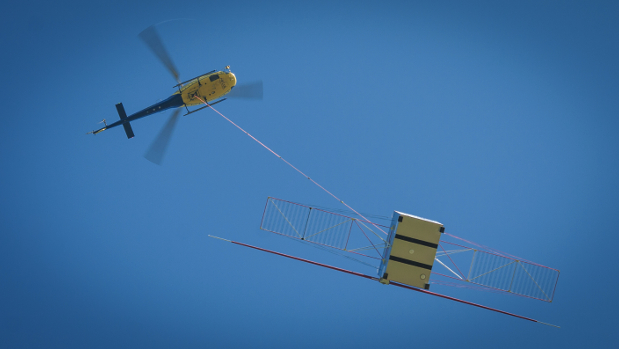The Radar for Icy Moon Exploration (RIME) instrument will be the first to look below the icy surface of Jupiter moons Europa, Ganymede and Callisto.
A key component for the European Space Agency´s deep space mission to the icy moons of Jupiter — JUpiter ICy moons Explorer (JUICE) — is being flight tested in Germany. The antenna for the Radar for Icy Moon Exploration (RIME) instrument was taken into the air suspended from a helicopter to verify the results of computer simulations, and measure the radio performance of the RIME antenna as if it was mounted on a spacecraft.
The tests took place at an airfield near the Friedrichshafen plant of Airbus, which is the prime contractor for the spacecraft. The 16.6m antenna was tested in various flight configurations during a two day campaign.
For three and a half years, JUICE will sweep around the giant planet, exploring its atmosphere, magnetosphere and dark rings, as well as studying its three largest icy moons — Europa, Ganymede and Callisto. The goal is to investigate whether there are liquid oceans under these icy crusts which might harbour potentially habitable environments.
The spacecraft will carry 10 state-of-the-art instruments, including the ice-penetrating RIME radar sounder. RIME is optimized for penetrating below the Galilean icy moons’ surfaces, up to a depth of 9km. It will provide images with a resolution of around 1km x 10km and 50m in depth. RIME will work at a central frequency of 9 MHz and will use a 16.6m dipole antenna.
The radar transmits radio waves which travel through the subsurface where they interact with any layers and structures with different dielectric constants. The varying reflections are detected onboard via the same antenna and used to create a depth image (radargram) of the subsurface. RIME will be the first instrument to be deployed to Jupiter and the outer Solar System capable of performing direct subsurface measurements.
In June 2022, the 5.5 ton spacecraft JUICE (JUpiter ICy moons Explorer) will set off on its nearly 600 million-km journey to Jupiter, where it is expected to arrive in late 2029.

